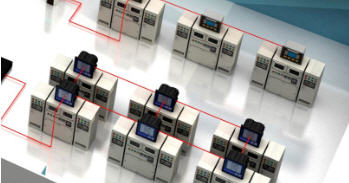Data centers employ a wide range of business models and vary greatly in size, scope, and implementation. For example, private data centers are often built by enterprises for their individual usage needs. On the other hand, colocation data centers can be much bigger than the average private facility and are designed for data center service providers to rent storage and computing capacity to midsize businesses migrating to the cloud. Whether they are comprised of traditional servers mounted on racks in a climate-controlled room in a brick-and-mortar building, or modular prefabricated building blocks designed for rapid deployment, all data centers require the same essential IT, power, cooling, fire protection and access control elements. As a result, any attempt to improve PUE must also address power management and environmental monitoring efficiency.
Critical Power Management
The high-performance servers in a data center rely on a wide array of power devices, such as ATSs (automatic transfer switches), meters, circuit breakers, and UPS (uninterruptible power supply) controllers, to ensure a constant supply of electricity and manage usage. Especially for colocation data centers, which derive their revenue from renting data processing and storage services to other companies, system downtime is unacceptable. Even an offline private data center could cost an enterprise hundreds of thousands of dollars an hour. In order to stay online and running at all times, network solutions in data centers must be able to withstand the electrical interferences commonly found in UPS rooms and electricity rooms. In fact, data center facilities contain a great deal of electromagnetic interference or even vibration. Only industrial-grade solutions with at least level 3 EMS protection, wide operating temperatures, and fast network recovery can ensure smooth, uninterrupted service for all critical power devices in a data center.
To guarantee high redundancy for Ethernet-based communications and remote monitoring of equipment in high noise environments, data centers can take advantage of industrial-grade network solutions with level 3 EMS protection. Besides having a robust, fanless design to achieve greater longevity, industrial-grade Ethernet solutions may also support smart network recovery options for proactive monitoring of remote equipment. For instance, Moxa’s Turbo Ring redundancy provides network recovery in < 50 ms for a backbone network, ensuring seamless operation. Industrial-grade Ethernet switches that feature a -40 to 75°C wide operating temperature range, level 3 EMS protection, and millisecond-level network recovery all help to minimize downtime for critical power management.

Environmental Monitoring
High-performance servers in data centers generate a substantial amount of heat. It is essential to ensure that all environmental conditions, such as air, temperature, and gas levels, are properly monitored and controlled in order to avoid affecting data center operations. As a result, data centers spend a great deal of energy costs on cooling and climate control. Acquiring precise, accurate, and timely measurements of these environmental factors, enables data centers engineers to respond to system anomalies immediately and minimize potential damage. For example, data centers that employ liquid cooling systems to dissipate the vast amounts of heat generated by the servers also need to install leakage sensors and alarms. To ensure that the cooling system is working properly and the servers do not overheat, data centers install a large number of sensors and I/Os for environmental monitoring. Simplifying the deployment of all these sensors and minimizing the total operating costs are key considerations for an optimal environmental monitoring network. Moreover, data centers also require a robust connectivity and networking solution ensure that the sensor data is precisely acquired and transmitted.
As with critical power management, high network availability can also optimize PUE for environmental monitoring. For example, data centers can benefit from an easy-to-use software configuration tool that enables fast deployment and minimizes support effort. Using hardware that features a modular design with flexible wire connections for myriad sensors and I/Os not only provides scalability, but also helps keep operating costs at bay by simplifying the network architecture. For example, using an Ethernet remote I/O with built-in 2-port switch for daisy-chain network topology allows data centers to save costs associated with deploying additional switches and wire runs. The easier it is for engineers to monitor the data center environment, the easier it is for them to reduce unnecessary power consumption and costs without affecting service.

Moxa’s Solutions
To help data center IT and IA engineers optimize power usage effectiveness for their facilities, a wide selection of industrial-grade Ethernet solutions are available. Designed specifically for ensuring high network availability for power devices and environmental monitoring systems in the high noise conditions, these products feature rugged design that provides EMC resistance, wide-temperature operability, as well as millisecond-level network recovery. Tailored features, such as simple control logic or Ethernet cascading, may also provide more flexibility and scalability to meet the different demands of data centers are also contribute to efficient energy consumption. Last but not least, smart I/Os that support SNMP and Modbus TCP also simplify data acquisition for environmental monitoring to keep critical systems online.
To learn more about industrial-grade Ethernet solutions for optimizing data center PUE, visit the website, or download the data center application flyer.